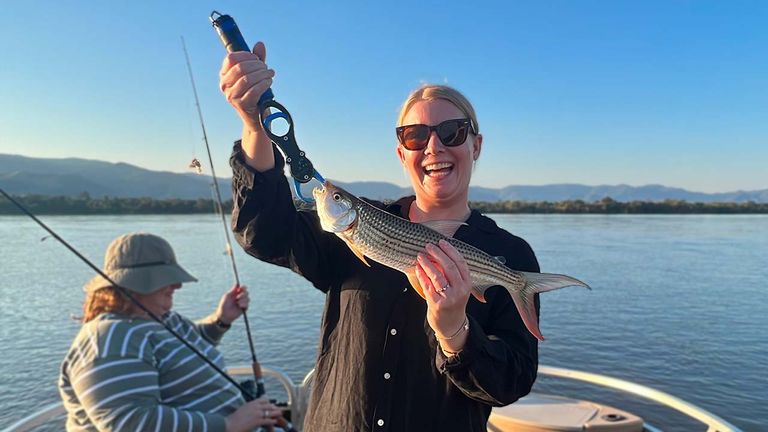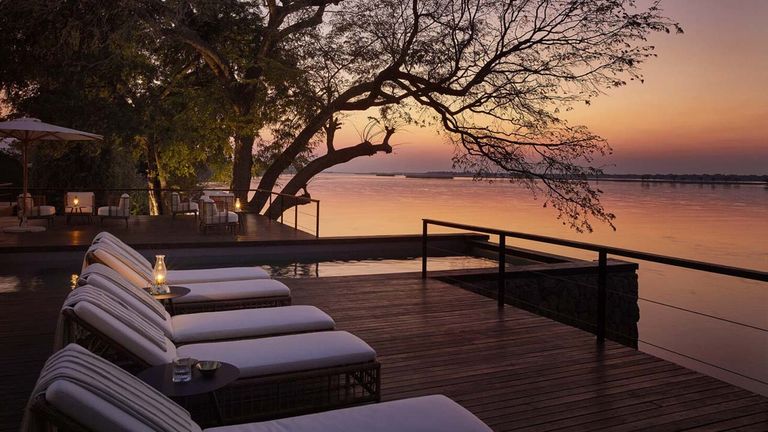A thunder of curious hippos gazed at the boat I stood in — from a reasonably safe distance — as I cast another line with my fishing rod. At the end was a hook with local bait, a piece of chessa fish, intending to lure one of the African tigerfish found in these parts of Zambia — a larger fish with sharp, undeniably predatory teeth.
I was hopeful to join the ranks of my companion Charlotte, who had caught and released one already, without any disruptions from a lurking elephant or crocodile. Fishing in the Zambezi River is just one excursion offered by Zambezi Grande.
The luxury safari lodge in the Lower Zambezi region is located on the Zambia side of the waterway, which doubles as the border with neighboring Zimbabwe. It took some time and several attempts, but I eventually reeled in my prized tigerfish, which weighed in at 9 pounds and measured about 16 inches (with big, 1-inch incisors) — a size worthy enough to be included in the lodge’s handwritten ledger.
 Catching and releasing an African tigerfish is one of the excursions offered by Zambezi Grande.
Catching and releasing an African tigerfish is one of the excursions offered by Zambezi Grande.
Credit: 2023 Erik Trinidad
I caught many other animals while in Zambia — with my camera lens, that is.
Although the country isn’t immediately in African tour conversations as with more popular destinations such as South Africa, Kenya, Botswana or even Rwanda, Zambia has the infrastructure to support any adventurous traveler ready to explore its wildlife and natural wonders, with activities from game drives and whitewater rafting to glamping and boat cruises. In fact, without mass safari tourism, Zambia has billed itself as an unspoiled slice of “Real Africa.”
Falling for Victoria Falls
Undoubtedly, the most frequented site in Zambia is Victoria Falls. A UNESCO World Heritage Site and one of the Seven Natural Wonders of the World, its proximity to the borders of Zimbabwe, Namibia and Botswana makes it a perfect bookend to a safari tour in that convergence of countries.
The planet’s largest group of waterfalls in terms of volume of water, Victoria Falls plunges as deep as 354 feet into the Zambezi River Gorge, which straddles Zambia and Zimbabwe. The waters have such a powerful and loud roar that locals know it as “Mosi-oa-Tunya,” or “The Smoke That Thunders.”
Views are best from the Zambian side in July and August, when the thick mist of high water season begins to subside. It’s then — and during the subsequent low water season from September through December — that views are best at one particular Zambian vantage point: Livingstone Island. Nearby, there are two natural pools to swim in right at the edge of the falls — Angel’s Pool and Devil’s Pool (either open depending on the season).
If that’s not thrilling enough, there are plenty of other exciting activities in and around Livingstone — a tourism hub on the Zambian side — including boat tours on the Zambezi, bungee jumping and whitewater rafting. The Zambian side also holds most of the higher-end hotels in the area, including the luxurious, river-facing Thorntree River Lodge on the Upper Zambezi, which offers guests the experience of floating on the river without ever leaving their suite.
Life and Luxury in the Lower Zambezi
The Upper Zambezi flows down Victoria Falls and continues as the Lower Zambezi, which snakes its way between Zambia and Zimbabwe, flowing toward Mozambique and eventually the Indian Ocean. Along its journey, the Lower Zambezi provides water for all the fauna and flora in its path, supporting a plethora of mammals, reptiles and birds — not to mention, those sharp-toothed African tigerfish.
 Elephants in the Lower Zambezi
Elephants in the Lower Zambezi
Credit: 2023 Erik TrinidadIn 1983, more than 1,500 square miles of the area was deemed a protected conservation area with the establishment of Lower Zambezi National Park. This showcase park is another main draw to the country; clients have a great chance of spotting lions, elephants, hippos, crocodiles, baboons, kudu, waterbucks and warthogs. At night, visitors may catch a glimpse of a wandering porcupine, curious civets or a stealthy spotted eagle owl.
Most of the notable luxury safari lodges here are just outside the park’s official riverside entrance, accessible by a short boat ride — although it doesn’t really matter if guests are outside the official park boundary, because animals wander in and out of the park freely to dwell in the adjacent, community-owned Game Management Area. Each safari lodge provides its own take on private game drives, boat cruises and experiences in and around the park and river, but I recommend Zambezi Grande.
 The pool at the Zambezi Grande
The pool at the Zambezi Grande
Credit: 2023 Zambezi GrandeThe five-star sanctuary elevates a safari with champagne brunches in the bush, gin and tonic sundowners with a view, and a signature dinner experience on an island in the middle of the river. The property’s general manager, Josh Isaacs, is a former sommelier, so clients can expect an African wildlife experience followed by fine dining with perfectly curated wine pairings.
Hungry Hippos in “Giraffic” Park
Rounding out the third most popular destination in Zambia is South Luangwa National Park, located in the eastern part of the country’s remote wilderness. Centered around the waters of the Luangwa River, this region is home to one of the highest concentrations of hippopotamuses in the world. (It’s also a territorial battleground for hippos and crocodiles, as seen in a National Geographic documentary about the area.)
Hippos aren’t the only creatures to spot during a game drive; there are also the usual daytime suspects of elephants, baboons, impala and many birds, plus hyenas, mongooses and scrub hares at night. However, South Luangwa National Park is best known for a particular giraffe species that can be spotted day or night: the Luangwa giraffe.
Endemic to the area, the creature is more commonly known as the Thornicroft giraffe and features a dark coat, dark tongue and irregular patterns, except for below its knees, where there is no pattern. The global population of this giraffe subspecies is only in the hundreds, so it’s no surprise they’re protected. In fact, the conservation of the Thornicroft giraffe was the impetus for the park’s creation in 1972. Today, they remain a precious animal to behold while on a game drive.
 Sungani Lodge
Sungani Lodge
Credit: 2023 Erik TrinidadThere are several bases for a safari in this remote part of Zambia. Many South Luangwa safari lodges are near the closest airport at Mfuwe, but if clients want to be remote, you may as well book them completely off the grid at the family-run Sungani Lodge, which requires an additional 20-minute southbound flight via the property’s private bush plane.
Upon drop-off, travelers will soon discover that being off the grid doesn't mean being devoid of style. Decorated by owners Paul and Lynne Davy, the modern-meets-rustic camp offers large, cabin-like glamping tents fitted with all modern amenities, private plunge pools and indoor and outdoor showers (and toilets) that face the adjacent Luangwa Lagoon. There, guests can observe hippos in the wild from a safe distance — from the comfort of their bath in a clawfoot tub.